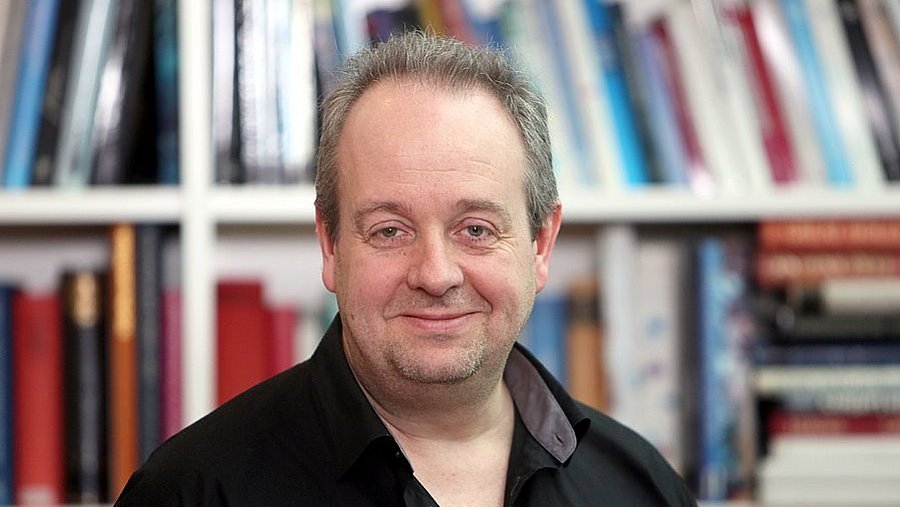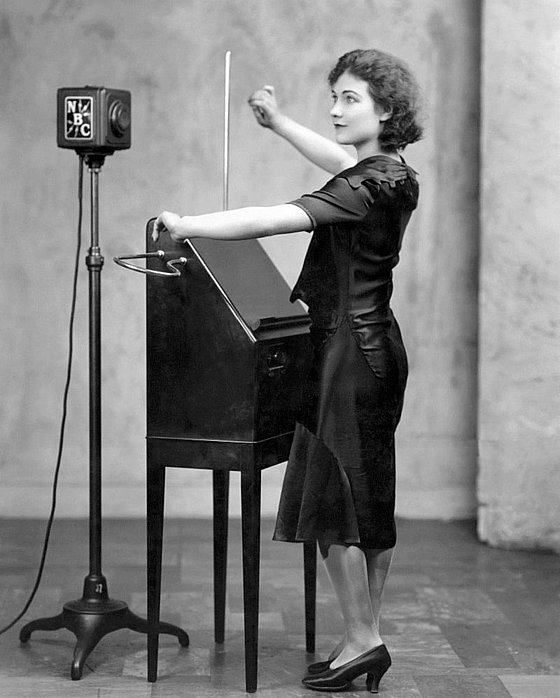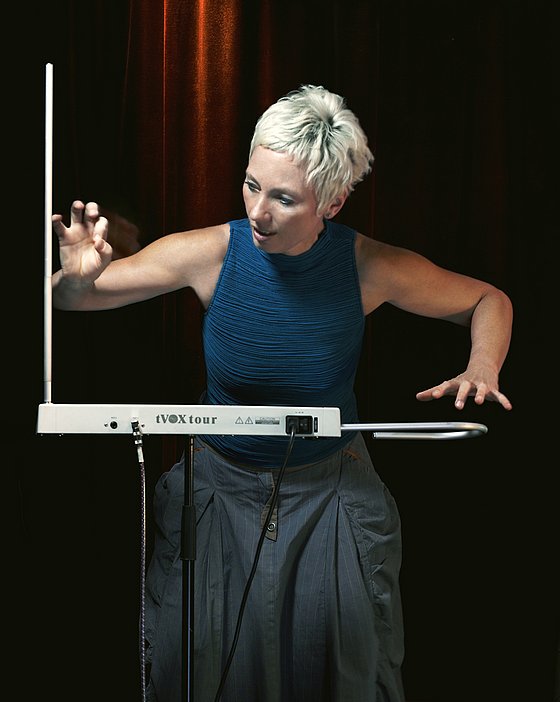
First theremin concert 100 years ago
Christoph Spengler / Director of the choir and orchestra of the University of Wuppertal
Photo: Sergej Lepke
How electromagnetic fields create contactless music
Christoph Spengler, Choir and Orchestra Director of the University of Wuppertalabout the first theremin concert 100 years ago
On 10 April 1925, the first public theremin concert took place in the Petersburg Philharmonic Hall. What is a theremin anyway?
Christoph Spengler: The theremin - originally called an aetherophone - is one of the very first electronic musical instruments. It basically consists of a box with two metal antennas, one vertical and one horizontal. The special feature is that the instrument is played without touching it. You move your hands in the air, and what looks like magic is simple physics. The theremin works with electromagnetic fields that emanate from the antennas. The position of the hands changes these fields - and this in turn changes the sound produced. The sound is often described as "ghostly, like a fragile female voice", which is certainly one of the reasons why it was used in the soundtracks of science fiction films, among other things.
The instrument is the forerunner of today's synthesiser.

Alexandra Stepanoff plays a theremin for NBC Radio in 1930
Photo: Public domain
Who invented it and how do you play it?
Christoph Spengler: The inventor is the Russian physicist Lev Sergeyevich Termen. He developed the instrument in 1920 and went on a world tour with his "ghost music" in 1927. During this tour, he settled in the USA, where he changed his name to Leon Theremin - hence the instrument's current name. In 1938, he returned to the USSR under seemingly unexplained circumstances, where he was arrested and virtually disappeared from the world public eye until 1964. During this time, interest in the instrument waned before it was "rediscovered" and continues to enjoy great popularity to this day.
Termen was actually looking for a method to measure gas densities when he realised that body movements in an electromagnetic field could be used to produce sounds. In the case of the theremin, this is done by the two hands. One hand controls the pitch, the other the volume. The change from one tone to another is always smooth - this is known as a glissando, which is one reason for the characteristic sound. Although it is basically easy to elicit tones from the instrument, shaping them in a controlled and targeted manner requires a high degree of practice and concentration as well as great physical control, as every movement, including that of the arms, immediately leads to a change in the sound.
In the beginning, the instrument was always referred to as ghost music. How did this come about?
Christoph Spengler: I think there are two main reasons for this, namely the sound and the way this instrument is played. On a piano or a guitar, the notes are clearly delineated. With the theremin, on the other hand, the notes glide continuously into one another. A similar effect can be achieved on a violin, for example, if you let your finger glide over the string while bowing. The electronically generated sound of the theremin, which does not come from a string or a vibrating column of air like a wind instrument, also has something spherical, almost uncanny about it and was completely new to the ears of the people of the time. Then there is the way it is played, because the instrument is not even touched when it is played. This had an almost magical effect on people in the 1920s, as it gave the impression that the sound came from nowhere. This also fitted in well with the spirit of the times, in which many people were fascinated by spiritualism and the occult.
Works were even composed especially for this instrument. But the theremin was mainly used in science fiction films. Hitchcock used it in his 1945 film "Spellbound" (German title: Ich kämpfe um dich). In the dream scenes of the psychodrama, the trance-like, lurching sound shatters the coordinates of reality, sends the ears on a meandering journey through hell, digging deeper and deeper into buried memories. Are these the strengths of the Theremins?
Christoph Spengler: Yes! These are the instrument's particular strengths. The sound of the theremin is outside of what we perceive as familiar in our natural environment. It is floating, shimmering, somehow otherworldly. Of course, this is ideal for underpinning scenes that deal with the uncanny, the dreamlike or the psychologically abysmal.
In Hitchcock's "Spellbound", the theremin was used specifically to make the main character's mental states audible - not just as a musical stylistic device, but almost as an inner monologue in sound form. The instrument was also used in science fiction films of the 1950s, for example by multiple Oscar winner Bernard Herrmann in the film "The Day The Earth Stood Still". He recognised that the sound was ideal for expressing the alien and extraterrestrial in sound - a true classic.
At the same time, the theremin also has a lyrical, sensitive side. In early concert works, for example by Bohuslav Martinů or Carolina Eyck, it is used in a very classical, melodic way and sounds almost like a singing voice. The spectrum therefore ranges from a cosmic journey of sound to a romantic solo voice.

Barbara Buchholz (1959-2012) plays on a TVox by G. Pavlov
Photo: CC BY-SA 3.0 de
After the 1950s, the hype surrounding the theremin was over and it was only rediscovered by the electro scene in the 1990s. Wasn't it then in direct competition with synthesizers?
Christoph Spengler: At first glance, the theremin does indeed seem to be in competition with the synthesiser - after all, both can produce electronic sounds that are different from those that classical instruments can produce. But there is a crucial difference: synthesisers usually work via keys, knobs or computer control. The theremin, on the other hand, remains a physically played instrument - with all its peculiarities, nuances and imponderables. And even after so many years that the instrument has been around, it remains fascinating to watch someone play it, moving their hands in the air to produce the sounds. Even though we know that it can all be explained in physical terms, there is still a magical quality to it.
And there is always something situational about playing the theremin: it reacts so sensitively to every movement of its player that it never sounds exactly the same. This sets it apart from the digital uniformity of modern samplers and synthesisers. It simply has a much stronger "human touch", offers greater scope for individual expression and therefore seems less "cool" than some synthesisers. I therefore see the theremin more as a nice addition to the synthesiser world, an instrument that has taken its very own place in the musical landscape, even if it is still perceived as a niche instrument today, but still has a loyal fan base.
Its builder, Lev Sergeyevich Termen, later Leon Theremin, disappeared without a trace for several years. What happened and what is still known about him today?
Christoph Spengler: Lev Termen's life was at least as unusual as the instrument he invented. After causing a worldwide sensation with the theremin in the 1920s and 30s, he suddenly disappeared from the public eye in 1938. It was long rumoured that he had been abducted from the USA by Soviet agents - in fact, he had already voluntarily returned to Moscow by this time, where he was arrested shortly afterwards on charges of "counter-revolutionary behaviour". In the West, he was considered missing and it was assumed that he had died.
He spent several years in a Siberian gulag, but was later transferred to a so-called "sharashka" - a secret research laboratory for prisoners where he developed surveillance technology for the Soviet secret service, among other things. This is said to have included an early precursor to the directional microphone.
Termen did not reappear in public until the 1960s. In the Soviet Union, he was now regarded as a deserving scientist who was even honoured with several awards. However, there was hardly any talk of his pioneering musical role. In the 1990s, at an advanced age, he travelled to New York once again, where he was received with great respect. He died in Moscow in 1993 - as someone who had lived in two worlds: music and technology, the West and the East, freedom and surveillance.

Inner workings of a modern theremin
Photo: CC BY-SA 3.0 en
The theremin is still used by many musicians today. They particularly appreciate the wider tonal range, i.e. more than the twelve tones that are normally used to make music in a Western cultural context. Could you imagine using the theremin in a concert with a choir and orchestra?
Christoph Spengler: You should never say never. I can well imagine that we might one day play a film score that features the theremin as an instrument. We've already worked with unusual instruments - most recently in January 2025, when we played a piece with dodgeridoo and orchestra. So if I ever get my hands on sheet music for a piece that is suitable for us and features a theremin and I find someone who can play it - why not?
Uwe Blass
Christoph Spengler studied church music in Düsseldorf. He took over the direction of the university choir in 2007 and the orchestra in 2011. In 2016, the rectorate awarded him the University of Wuppertal's Medal of Honour. In 2017, he was appointed church music director by the Protestant Church in the Rhineland.
